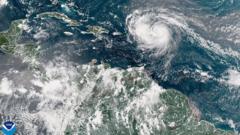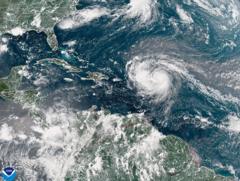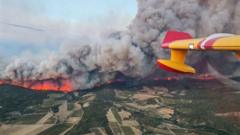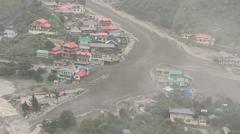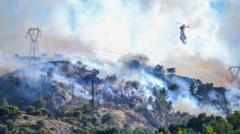As the hurricane continues on its path, residents in affected areas are urged to prepare as dangerous weather conditions loom.
**Hurricane Erin Intensifies, Threatening Life-Saving Evacuations on the US East Coast**

**Hurricane Erin Intensifies, Threatening Life-Saving Evacuations on the US East Coast**
Hurricane Erin escalates to a Category 4 hurricane, prompting warnings for dangerous surf and rip currents along the eastern coast of the United States.
Hurricane Erin has intensified to a Category 4 storm, posing a significant threat of life-threatening surf and rip currents to the eastern shores of the United States. Currently impacting the southeastern Bahamas and Turks and Caicos Islands, residents are under a tropical storm warning as heavy rains are expected, with forecasts predicting totals of up to six inches (15.2 cm) of rain. Although Erin has shown fluctuations in intensity, transitioning to a Category 5 before descending slightly, it is now regaining strength.
In Puerto Rico, over 150,000 residents experienced power outages as fierce winds damaged power lines, although local energy provider Luma reported that emergency repairs restored service to 95% of affected customers by Sunday evening. The hurricane's outer bands have begun to hit the Bahamas, with local authorities advising residents to stay informed about shelter options. Aarone Sargent, the Bahamas' Disaster Risk Management Authority's managing director, emphasized the unpredictable nature of storms, urging preparation for sudden changes in the storm's trajectory.
The current forecast suggests that the core of Hurricane Erin will navigate east of the southeastern Bahamas before heading toward Bermuda and the eastern US coast later this week. The storm is expected to remain "large and dangerous" throughout, resulting in preparations for high surf and strong winds in the Outer Banks of North Carolina, where mandatory evacuations have been ordered for Hatteras Island. Authorities are concerned that the main connecting road could become impassable due to flooding and debris. Forecasters additionally caution that hazardous rip currents could pose risks along the entire US East Coast as Erin approaches.
In Puerto Rico, over 150,000 residents experienced power outages as fierce winds damaged power lines, although local energy provider Luma reported that emergency repairs restored service to 95% of affected customers by Sunday evening. The hurricane's outer bands have begun to hit the Bahamas, with local authorities advising residents to stay informed about shelter options. Aarone Sargent, the Bahamas' Disaster Risk Management Authority's managing director, emphasized the unpredictable nature of storms, urging preparation for sudden changes in the storm's trajectory.
The current forecast suggests that the core of Hurricane Erin will navigate east of the southeastern Bahamas before heading toward Bermuda and the eastern US coast later this week. The storm is expected to remain "large and dangerous" throughout, resulting in preparations for high surf and strong winds in the Outer Banks of North Carolina, where mandatory evacuations have been ordered for Hatteras Island. Authorities are concerned that the main connecting road could become impassable due to flooding and debris. Forecasters additionally caution that hazardous rip currents could pose risks along the entire US East Coast as Erin approaches.


